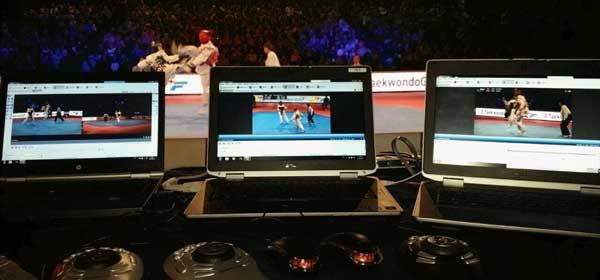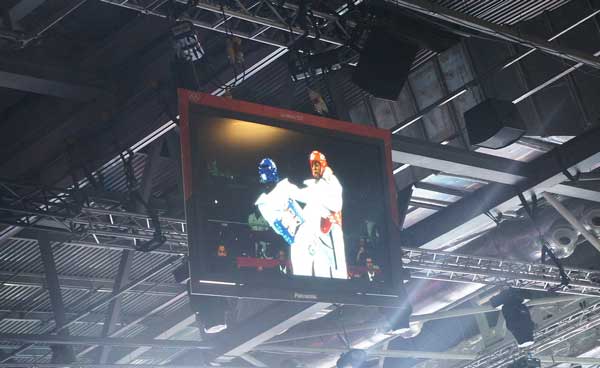
In the blink of an eye, there it is. A kick to the head that, as a spectator sitting back in the stands, you almost missed. That was a crucial three points for your player and now she takes the lead! This is the lightening fast excitement of WTF Taekwondo.
But wait… the judges haven’t awarded the score. The competitors’ protective vests are wired to detect contact but not the headgear, so it’s still human beings that make the call. For those high scoring head kicks must you simply accept the decision of the official? Until 2009, that was the case but then the World Taekwondo Federation brought Dartfish instant replay into all major championships and with it the power of appeal was granted to players and coaches.
That’s what happens on this occasion – the player appeals and her coach indicates agreement by raising a blue card.
Dartfish technology helps judges & fans
Either one or both of two technologies are used. The first caches a predetermined duration of video from a live feed from two cameras simultaneously. As each decision or appeal is made a button is pressed which first saves the preceding thirty seconds of action… and then instantly replays it — both to the judges’ computers and to the fans via the arena’s giant screen.

The second system is more commonly used because the WTF also archive every fight on their dartfish.tv channel, so they want videos of complete fights and not just short sections. Thousands of videos are available to the public and all are ‘tagged’ at the key positions where decisions or appeals are made. Fans across the world can watch the fights or search out their own choice of highlights.
Rather than using the software’s button panel, Taekwondo judges manage everything; from the naming and categorization of videos, to the starting and stopping of recordings and of course the tagging of events within the fight, using their electronic judging panel, which wirelessly interfaces with the software.
Again a live video feed is captured by Dartfish but this time the entire fight is recorded from start to finish and the judges have an array of buttons to tap, each of which indicates the decision being made and marks the appropriate segment of video with that label.
When an appeal is made, judges can return to the last tagged event, or indeed any part of the video, even as recording continues. Then, slow motion replay makes the final decision clear to judges and fans.
There is no longer any doubt – in slow motion and from both camera angles recorded, it is clear that a head contact was made and the point is awarded. Get back on the edge of your seat, the fight is on!

Comments are closed.